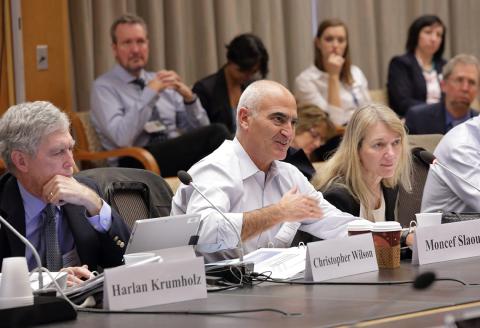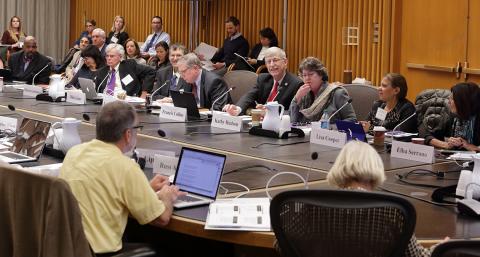111th ACD Meeting
Ambitious Agenda Engages Advisors to NIH Director

Setting the Precision Medicine Initiative in motion, unveiling the first NIH-wide Strategic Plan in 20-plus years and fine-tuning HIV/AIDS research priorities were just three of the hefty items packing the Dec. 10-11 agenda of the advisory committee to the NIH director (ACD). The group’s 111th meeting convened just a day before the latest temporary federal funding mechanism was due to expire, potentially triggering a government shutdown. However, NIH director Dr. Francis Collins expressed confidence and optimism about NIH’s financial outlook.
“It has been very gratifying for me to see over the course of this entire year the strong bipartisan support for the importance of biomedical research,” he said, opening the ACD meeting, “for the advances that it makes possible in human health, for the way it encourages the economy and for the ways it encourages American competitiveness. The latter is an issue of considerable concern to many members [of Congress]. Almost without exception, this has been a year where, regardless of people’s political views on other matters, the topic of medical research resonated as one that needs to have more attention.
“We’ve gone through a pretty tough time here since 2003—since the end of the doubling, where [grant funding] success rates have continually fallen,” Collins continued, describing his dozens of meetings, briefings and hearings with congressional decision-makers, many of whom have also visited the NIH campus. “This is not a healthy situation for the United States and needs to be attended to…hopefully all of the statements and expressions of goodwill will translate into something we will all be able to celebrate next week.”
[On Dec. 18, President Obama signed into law the FY2016 Omnibus Bill, giving NIH a $2 billion increase in its fiscal year 2016 budget. In a statement, Collins called it “the most encouraging budget outcome in 12 years.”]

Following the director’s report, in which Collins highlights what happened at NIH in the 6 months since the last ACD meeting, the group tackled several issues that sparked lively discussion.
The NIH plan to implement the Precision Medicine Initiative Cohort Program topped the ACD’s schedule on day one and a look at innovative research at the National Eye Institute led day two (see sidebars).
Articulating Our Priorities
It had been more than 20 years since NIH attempted the daunting task of putting its broad, trans-institute goals and tactical approaches into a single document. Early in 2015, Collins took up the congressionally mandated challenge to craft an NIH-wide Strategic Plan within a year.
“We took this as a real opportunity to try to articulate what we see as scientific opportunities, how we set priorities and how we think about our role in terms of stewardship,” said Collins. “All of [those considerations] were folded into this plan.”
NIH principal deputy director Dr. Lawrence Tabak was tapped to lead development of the plan, chair the committee of institute and center representatives that hammered out a framework for the document and solicit input on it from various NIH stakeholders both inside and outside the agency. The ACD reviewed a preliminary outline of the plan at its June 2015 meeting; the final was due to Congress on Dec. 16, 2015.
“Truly this has been a team sport,” Tabak said, presenting highlights. “The goal was that the plan should clearly articulate the highest trans-NIH priorities and how we will achieve them. Everyone agreed it needs to be a living document because of the rapidity with which science moves forward.”
[In a Dec. 16 statement, Rep. Andy Harris (R-MD) said, “This groundbreaking NIH-wide strategic plan is an important first step toward increasing accountability and resource prioritization at NIH.”]
New Intramural Component Announced
In mid-May 2015, the Food and Drug Administration held an unannounced inspection of the Clinical Center pharmacy. Inspectors observed several concerns with physical facilities as well as procedures and personnel training. Sterile operations in the CC pharmaceutical development section (PDS) were halted.
By early June, Collins had formed an internal PDS task force cochaired by NIH deputy director for science, outreach and policy Dr. Kathy Hudson and Tabak. External consultants also were engaged for an independent look at the situation. As a result of findings by these groups and meetings with FDA, Collins plans to set up a new quality assurance component, the Office of Research Support and Compliance, within the Office of Intramural Research.
In addition, a new ACD working group on the Clinical Center was formed by the NIH director; a familiar face, Dr. Norman Augustine, will chair the group. A research engineer and retired CEO at Lockheed Martin, Augustine is well-known as a wise advisor to the NIH community, most recently as head of the Scientific Management Review Board. Read Collins’s statement on the PDS at http://1.usa.gov/1lWsSJ2.
The Ultimate Goal for AIDS: Ending the Epidemic
Many now argue that the scientific opportunity has emerged to eliminate one of the most devastating public health pandemics in the last 35 years: The potential for an “HIV/AIDS-free generation” is within our grasp, according to experts in the field.

As a result, NIH—via its Office of AIDS Research—has taken an aggressive look at its science portfolio on the disease across all components. Beginning with fiscal year 2016, AIDS funding—intramural as well as extramural—will support only research that falls within the highest priorities for the next 3-5 years, said acting OAR director Dr. Robert Eisinger, who presented the portfolio review findings and the four recently honed priorities at the ACD meeting.
“We have come a long way” but HIV/AIDS still poses a significant public health threat, Collins noted. “Our therapies are successful if available, but not perfect. Ultimately we want to move in the direction of achieving a complete eradication of this disease…To get there, this would be a very unfortunate time to take one’s foot off the accelerator. We can see opportunities in such areas as vaccines, and maybe even a cure, that deserve the most intense attention.”
The ACD also received updates from the HeLa working group and NIH’s Big Data effort. Video of gavel-to-gavel ACD proceedings is archived online at videocast.nih.gov.
NEI Capitalizes on Decade of Remarkable Biology, ‘Audacious Goals’

At the Dec. 11 meeting of the advisory committee to the NIH director, NEI director Dr. Paul Sieving offered “a quick and limited tour” of research at his institute, focusing on two areas—the Audacious Goals Initiative and “some of the interesting breakthroughs that have come out of paying attention to the genetics of eye disease.”
The overarching goal of the 12- to 15-year AGI, he said, is to “regenerate neurons and neural connections in the eye and visual system.” Not only will such an objective have a major impact on a wide variety of eye and vision-related disorders and conditions, Sieving suggested, but also it could shed light more broadly on regeneration in the central nervous system and spinal cord.
“My idea is to accelerate the trajectory of science,” he explained, discussing the origin of AGI. “I value all research, but in this context I value research that will get us to an endpoint of neural regeneration to restore human vision.”
Targeting “bold, inspiring ideas that fundamentally advance vision research and care,” the 2012 AGI Challenge Prize competition brought in nearly 550 submissions; 308 of these came from scientists with no previous NIH grant experience. NEI awarded prizes for the top 10 ideas selected by a federal panel and then used those ideas to shape the audacious goals. NEI announced the first AGI grants, funding research on functional imaging of the visual system, in May 2015.
Sieving also provided ACD members a brief overview of NEI: The institute’s budget for fiscal year 2015 was $677 million. As with most NIH components, the lion’s share—82 percent—was distributed to NEI’s extramural community. About 18 percent to 20 percent of its grant applications were funded. Two-thirds of NEI’s applications were for new projects, with one-third of the new applications coming from new investigators.
NEI’s intramural budget for the same period was $53 million, with 25 lab sections in 5 labs and 50 active clinical protocols.
Sieving pointed out how vision research stacks up when competing with other aspects of neuroscience in general, using the Brain Research through Advancing Innovative Neurotechnologies (BRAIN) Initiative as an example.
“The first BRAIN awards went out in 2014,” he noted, “and vision research did quite well,” garnering 41 percent of awards and 47 percent of the funds. “Because of the organized neural structure of the retina, it is a great place to do discovery on how neural systems are organized.”
Among breakthroughs in the genetics of eye disease cited by Sieving were the use of iPS cells in replacing diseased tissue in the retina and first-ever trials using human stem cells as therapy to treat age-related macular degeneration and Stargardt disease.
“Discoveries of the last decade present remarkable opportunities for vision research,” Sieving concluded. “NEI supports a full spectrum of research, from basic discovery to translational and clinical trials that affect clinical practice…[AGI] puts a spotlight on a place we want to reach.” With concerted effort by scientists from many disciplines, “current momentum promises that we will reach the goal.”
In comments afterward, ACD member Dr. Huda Akil of the Molecular and Behavioral Neuroscience Institute at the University of Michigan said that in her years of experience of talking with investigators in the field, “[It’s from] the people who have been doing the visual research—especially the retinal-related [projects], from year to year, [that] we see the most dramatic progress across different fields of neuroscience. In other areas, you see incremental changes here and there, but the visual stuff is just amazing. The field seems ripe for really transformative [breakthroughs].”
Fellow ACD member and cochair of ACD’s BRAIN work group Dr. Cori Bargmann of Rockefeller University agreed: “The quality of the research and the advances that have happened at the NEI [are] really spectacular. I think that’s partly because smart people like to be with other smart people, and there have been some very smart people specifically in visual neuroscience. I feel like the rest of neuroscience [has] looked up to them since [1981 Nobelists David] Hubel and [Torsten] Wiesel. But I think it’s also a sign of the leadership at NEI consistently and its support of science and promotion and protection of the best research. You have a very good reputation in the extramural community as an institute that works extremely well with scientists and it’s great to see that at every level, from the molecular to the clinical.”

